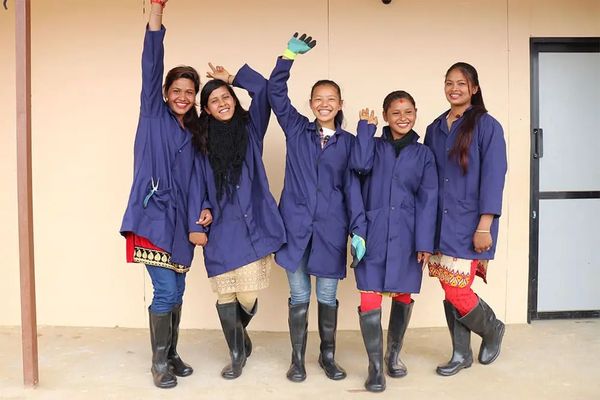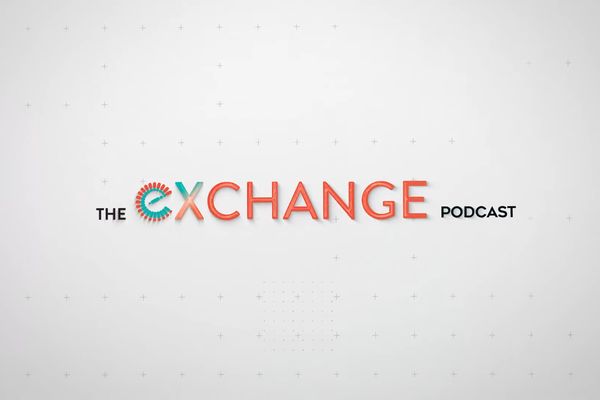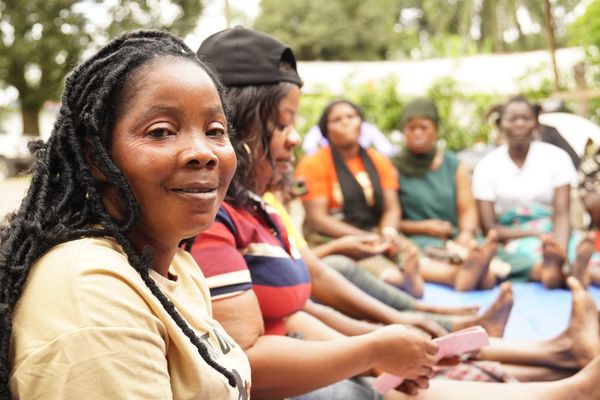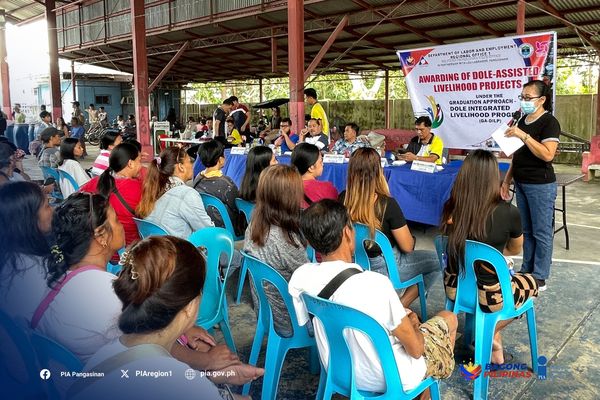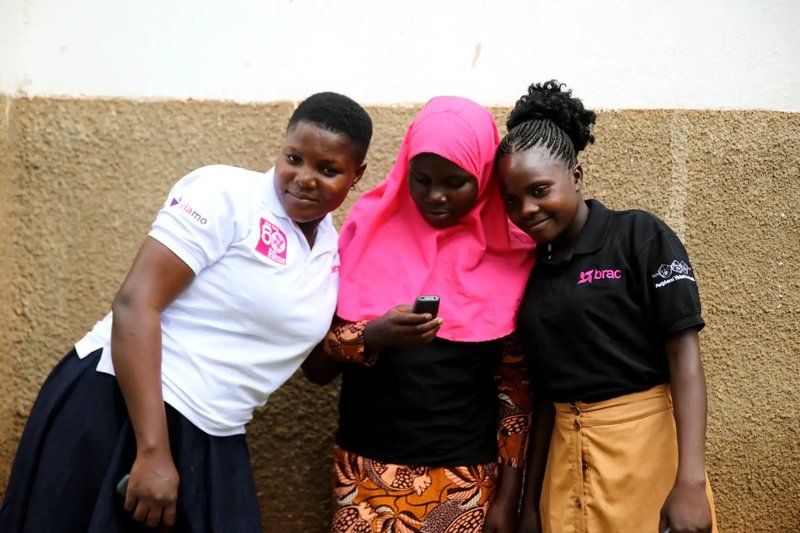
Jenna Grzeslo, Head of Research & Learning, BRAC International
Ilyena Kozain, Deputy Director of Strategic Partnerships, Viamo
Never underestimate the power of a good story. This is what BRAC had in mind when designing the BRAC Girls Talk project, which uses basic feature phones to deliver social empowerment content to adolescent girls and young women.
Imagine a young woman in rural Uganda, age 17. Neither she nor her friends have smartphones. One-way media like radio and television don’t interest or reach her. But increasingly, she has access to a basic mobile phone, and when she can afford to do so, she may spend much of her free time chatting with friends. With BRAC Girls Talk, she can engage in interactive stories with supportive social messaging for girls navigating the pressures of adolescence for free.
“Hello, and welcome to BRAC Girls Talk.” This is how it begins. Listeners then hear stories about Hawa, Jennifer, and Fatima – three BRAC created characters who could easily be their peers.
The stories are entertaining, sometimes funny, covering topics like sexual and reproductive health, finances, planning for the future, and cultivating overall well-being.
Using the phone’s keypad, listeners play games by answering how the girls should react to certain situations – much like a “choose your own adventure.”
As the narrator says, “These friends will be able to help you too, so you can learn together.”
Background
BRAC Girls Talk uses the power of gamification and storytelling to deliver educational programming to adolescent girls and young women via feature phones. A collaboration between BRAC Uganda, Viamo, and Peripheral Vision International (PVI), the content for BRAC Girls Talk focuses on the typical challenges girls and young women face during adolescence. Using PVI’s Wanji Games format, BRAC Girls Talk engages users with spoken audio and interactive voice response (IVR) technology. Needing no more than a feature phone, BRAC Girls Talk connects users to interactive, educational content that is delivered through interactive voice response.
In August 2022, BRAC Girls Talk was launched. The pilot reached 300 adolescent girls and young women and provided them with feature phones and access to the BRAC Girls Talk content. Learnings from the three month pilot are available in an operational report.
After the pilot was completed, the partners convened a committee to reflect on the successes and challenges of the project to date and operationalize the scale up of BRAC Girls Talk. The committee selected four games to be scaled up: Budgeting, Saving, Journeys, and HIV awareness. This blog post primarily focuses on early learnings from the scale-up phase of this project.
Promoting BRAC Girls Talk
While the pilot reached 300 BRAC participants in the Kayunga district of Uganda, during the scale-up phase of the project, anyone in Uganda with access to a mobile phone and the mobile service provider Airtel could access the BRAC Girls Talk games for free. To promote IVR content on the platform, Viamo sends SMS messages to registered users encouraging them to call in: “Call 161 now for free, press 2 then 7 and play Wanji games.” This did not specifically promote BRAC Girls Talk but rather Wanji games more broadly. Users receive about 5 SMSs a month, mostly about promoting content on the platform and also reminding them about their free calls in case they have not exhausted them.
Demographic Trends in User Data
We looked at usage data from March 1st to September 26th, 2023. During this time, there were over 235,000 unique listeners, with 79% of those listeners registered (i.e. consented to share basic demographic information) with Viamo. Viamo has background data on registered users, so we can explore what over two-thirds of BRAC Girls Talk listeners look like. Of registered listeners, 40.3% are female. In addition, we see that 15.1% are under the age of 18 and 54.2% are 18 to 24. Of the six languages available, Luganda is the most commonly selected language, with 61.1% of listeners choosing this option. Almost one third (32.5%) of listeners have agriculture as their main source of income. We see a trend that BRAC Girls Talk listeners, who are registered with Viamo, are not the target audience for our content: they are young men. This is representative of the higher proportion of registered male listeners on the Viamo platform and indicates that this content, which was directly created for young women, transcends the gender barrier in its relevance for young men also.That said, the survey of registered users does not capture the sharing of phones and we understand phone sharing, especially among young women, to be a frequent practice. Therefore, we would need to conduct follow-up research to understand this further.
Only about one third of registered listeners are calling in on a phone that they own. The majority of these listeners (85.9%) are calling in using a basic or feature phone compared to just 14.1% who own a smartphone. A specific study of 6,000 women in Uganda found that of registered female listeners who participated in the study and who do not own a phone, 49% reported they always need permission to use a phone, compared to 24% who noted most days and 13% who noted sometimes. Not only are young women less likely to be phone owners, they also encounter barriers to accessing phones to engage with BRAC Girls Talk content.
These insights present both opportunities and challenges for the future of BRAC Girls Talk. First, much like Viamo’s predominant user base on the 161 toll-free line, we know we are organically reaching more men than young women. Therefore, we could explore additional ways to improve listenership among our target demographic. Alternatively, we could also explore the role that listening to BRAC Girls Talk content plays in the development of young men’s views of women’s empowerment.
Promotional strategies alone will not increase listenership among adolescent girls and young women. We recognize that there are challenges to consider including a persistent digital divide for adolescent girls and young women.
Reflecting on Content Choices
While analyzing the usage data, we noticed some interesting trends. In particular, of the four Wanji games that were selected for the country-wide scale-up, we observed the greatest level of engagement with the game “Journeys.” 64,066 listeners compared to the next highest game, “Budgeting” with 10,512 listeners.
The Journeys game opens with a message from the Narrator, a trusted voice heard throughout the content. “Today we’re going to be talking about our futures, and exploring our life journeys. We’ll be finding out more about different jobs and careers from Sarah, a local mentor, and we’ll be helping Hawa work out a journey toward reaching her goal.” The game focuses on developing aspirations in users but also aiming for goals that can be attainable for our target audience.
To try and unpack this trend in the usage data, we sat down with Josie Gallo (Program Manager, Peripheral Vision International). Josie is the media development specialist who took BRAC’s youth empowerment curriculum and adapted the content to Wanji’s format. We asked her how she approached taking the curriculum and adapting it for IVR. She explained,
“We really wanted a sense that BRAC’s characters formed a cast that was recurring in the games, and the listeners can develop a parasocial relationship with them. The characters represent diversity in Uganda: different religions, in and out of school, and different skill sets. This is the first time that PVI has created a virtual world through Wanji games. Usually, it’s standalone games.”
As we dove deeper into why so many listeners are drawn to “Journeys” over the other games, Gallo explained that this content doesn’t really exist elsewhere in the same way that people can get family planning content. “This may be the first time, for a lot of people, that they’ve had a conversation about their choices.”
Description of the three characters
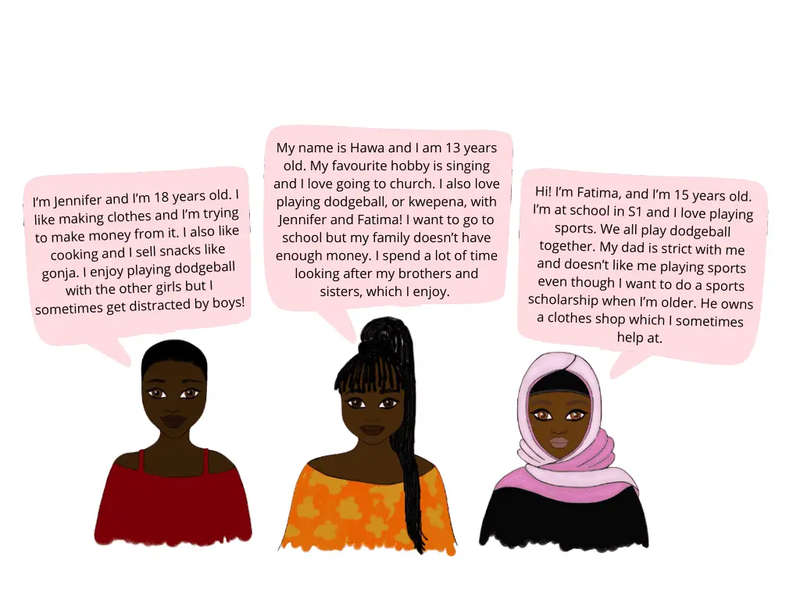
Looking ahead
As we look toward the future of BRAC Girls Talk, the partners are exploring opportunities to continue this work. With additional support, we could reach more adolescent girls and young women by adapting the content to new geographies. We have also considered the possibility of taking BRAC’s adolescent boys and young men’s youth empowerment curriculum and creating games that would specifically target this group. We already know that young men often make up a large share of Viamo’s listener base. Finally, we would also like to evaluate the impact of the games at scale.
For questions about BRAC Girls Talk, please contact Jenna Grzeslo (Head, Research & Learning, BRAC International) at [email protected].
